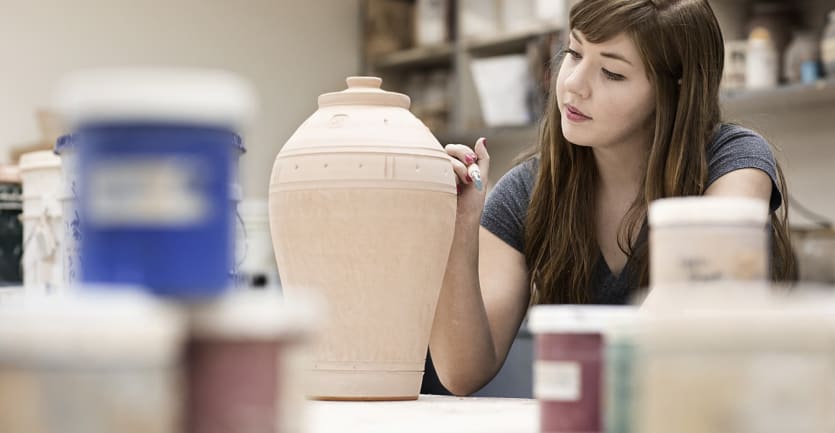The Value of an Art Degree
Writer
Writer
www.bestcolleges.com is an advertising-supported site. Featured or trusted partner programs and all school search, finder, or match results are for schools that compensate us. This compensation does not influence our school rankings, resource guides, or other editorially-independent information published on this site.
Turn Your Dreams Into Reality
Take our quiz and we'll do the homework for you! Compare your school matches and apply to your top choice today.
- Art programs emphasize collaboration, constructive criticism, and creativity.
- Many art degree-holders are self-employed and work as freelancers.
- A master's degree can advance your art career and prepare you for college-level teaching.
- Though helpful, an art degree isn't always necessary for pursuing a career in art.
This year has been rough for professionals. As countries contend with the pandemic-driven economic downturn, many companies and corporations are being forced to lay off employees, downsize or, even worse, shut down operations entirely.
All of this has dealt a tough hand to creatives. Some professionals have lost their jobs or seen their businesses take a major hit. These losses are compounded by the fact that many colleges and universities, including art schools, are dealing with public health risks and potentially large enrollment declines.
Art schools, however, face an additional problem: the inability to hold in-person classes. Hands-on learning is key to fostering creativity and artistic innovation. Due to COVID-19, art students must now hone their skills and find inspiration while learning at a distance. This raises the question: Is pursuing an art degree worth it?

What Skills Will You Gain in an Art Degree Program?
Despite the stigma surrounding art majors, an art degree can be an excellent opportunity to develop and hone the studio skills necessary to forge a career as a professional artist. Both the environment and length of the program allow students to learn relevant tools and surround themselves with like-minded individuals.
In an undergraduate art program, you'll analyze and discuss various art subjects, critique and assess your peers' work, and develop a keen understanding of your focus area. You'll also gain more professionally oriented skills like time management, interpersonal communication, and critical thinking.
In an art program, you’ll analyze and discuss various art subjects, critique and assess your peers’ work, and develop a keen understanding of your focus area.
Art students spend much of their time working in school facilities, like art studios and computer labs. These environments encourage individuals to create their best work while building a rapport with other creatives. Faculty are usually there to aid students in and outside of class.
While foundational and discipline-specific courses are the basis of every major, the theoretical and historical courses in an art program allow students to gain an understanding of art history. These classes broaden students' awareness of different art styles and techniques.
Some programs, such as interior and fashion design, are more specialized than others, allowing you to concentrate on a specific vocation rather than a general overview. Other programs deal with the business side of art and delve into areas such as fashion merchandising and art administration.
What Can You Do With an Art Degree?
Art degree-holders can choose from among many professional avenues. Some work as freelancers, while others find work through more traditional means. Some brave souls even take the entrepreneurship route and start a business.
The median salary for arts and design careers is $48,130.

Creative occupations can be found in fields like visual arts, design, media, and communication. Potential careers include becoming a writer, sculptor, graphic designer, and interior designer.
According to the Bureau of Labor Statistics, the median salary for arts and design careers is $48,130, or about $8,000 higher than the median annual wage for all jobs. Though most art careers have below-average job outlooks, some, like multimedia artists and animators, continue to grow at a steady rate.
Aspiring artists and art students can search for jobs by networking, utilizing their school's career services, and attending career fairs.
| Job | Minimum Degree Required | Median Salary (2019) |
|---|---|---|
| Art Directors | Bachelor's | $94,220 |
| Multimedia Artists and Animators | Bachelor's | $75,270 |
| Fashion Designers | Bachelor's | $73,790 |
| Industrial Designers | Bachelor's | $68,890 |
| Interior Designers | Bachelor's | $56,040 |
| Graphic Designers | Bachelor's | $52,110 |
| Craft and Fine Artists | High school diploma | $48,760 |
| Floral Designers | High school diploma | $28,040 |
Source: Bureau of Labor Statistics
Gig Economy
Most art-related occupations boast a significantly higher rate of self-employment than other careers. Many art majors choose to freelance or own a business. Some graduates in fields like writing, photography, and visual art can generate a sufficient income by selling their creative work and merchandise or by offering their services to clients.
Being able to successfully and enthusiastically promote your work is critical.
Traditional Track
Despite the free-spirited nature associated with the arts, many degree-holders secure full- or part-time jobs at companies, corporations, and agencies. Some graduates work long-term jobs in their chosen field, whereas others hop from industry to industry utilizing their creative skills.
Most art-related job openings at companies require candidates to possess at least a bachelor's degree.
Pursuing a Graduate Degree in the Arts
Many art majors earn their BA or BFA and never look back, but some choose to attend graduate school to advance their careers and concentrate on a specialized area of study. A master's degree can enhance your portfolio, increase networking opportunities, and diversify your career paths.
MFA and MA degree-seekers often use graduate school to refine their artistic philosophy and creative techniques while elevating their quality of work. Some graduate art students choose to enroll in a dual-degree program, in which they earn two graduate degrees simultaneously, such as an MBA or MS along with an MFA or MA.
A master’s degree can enhance your portfolio, increase networking opportunities, and diversify your career paths.
Another reason to pursue a master's degree is to be able to teach at the college level, primarily at community colleges. As an art instructor, you'll critique and guide up-and-coming creatives. Be aware that art professor positions at four-year universities will most likely require you to have a doctorate.
While some MFA degree-holders go on to establish lucrative careers, most graduates earn a modest salary. PayScale data indicates that the average MFA degree-holder makes around $61,000 a year.
Is an Art Degree Worth It?
Like any college major, an art degree's worth can be measured in many ways.
The benefits of obtaining an art degree include being able to heighten your creative efforts and collaborate with other artists across different disciplines. Taking a variety of art courses also prepares you to be flexible for your future career.
Another perk of majoring in art is that you'll receive guidance from industry professionals, such as local museum curators and award-winning writers and artists. Many times, these professionals have a residency or are part of the school faculty. This career guidance can aid in seeking and obtaining internships.
Meanwhile, some of the downsides of majoring in art include occasional unconstructive criticism and a stressful workload with tight deadlines.
The main drawback of an art degree is the financial burden.

But the main drawback is arguably the financial burden many art students take on in order to earn their degree. While the cost of a bachelor's or master's program can vary depending on the school and the student's needs, many renowned art schools — most of which are private — charge around $30,000 or more per year in tuition and fees. These colleges usually try to offset the high cost through scholarships and grants, but students often end up in deep debt.
In many ways, a BA, BFA, MA, or MFA is closer to a seal of approval in the art world rather than a full-on jumpstart to an art career. Sure, having a prestigious art school on your resume can help further your career, but it's ultimately your talent, knowledge, and determination that'll allow you to get the job you want.
These days, many creative-minded people utilize the internet and social media to enhance their skills, strengthen their profiles, and secure work without getting an art degree. YouTube and LinkedIn, for example, offer numerous learning opportunities and certificates. Networking with industry professionals and completing an internship can also help you break into the art world without having to go to school for it.
As long as you have the talent, network, and some training, you can pursue a career in art. That said, having a bachelor's degree makes you more qualified for certain jobs and more likely to make a higher, steadier income.

The Future of the Arts
Employment prospects have dimmed as the economy struggles to recover from the pandemic. Many companies in the creative sector have downsized or eliminated departments specializing in areas like design, marketing, and advertising. Self-employed artists and those managing small businesses are also struggling to stay afloat.
Despite all of this, the remote approach many companies are taking now might actually benefit art careers in the long run. According to an article in Florida International University News, jobs in the arts, design, entertainment, sports, and media rank more highly as telework-compatible than salaried positions.
Jobs in the arts, design, entertainment, sports, and media rank more highly as telework-compatible than salaried positions.
While a remote work situation works well for less interactive art forms, fields such as the dramatic and performing arts rely on proximity to rehearse and deliver results. The temporary halt to in-person working may hurt now, but experts say those areas will be able to adapt and rebound quickly.
In the end, it's up to you to determine whether you should get an art degree. Even if you don't technically need a BFA to enter your chosen field, possessing a college degree almost always looks better to employers than not having one, especially if you plan to pursue a more traditional career path.
Feature Image: SeventyFour / iStock / Getty Images Plus




